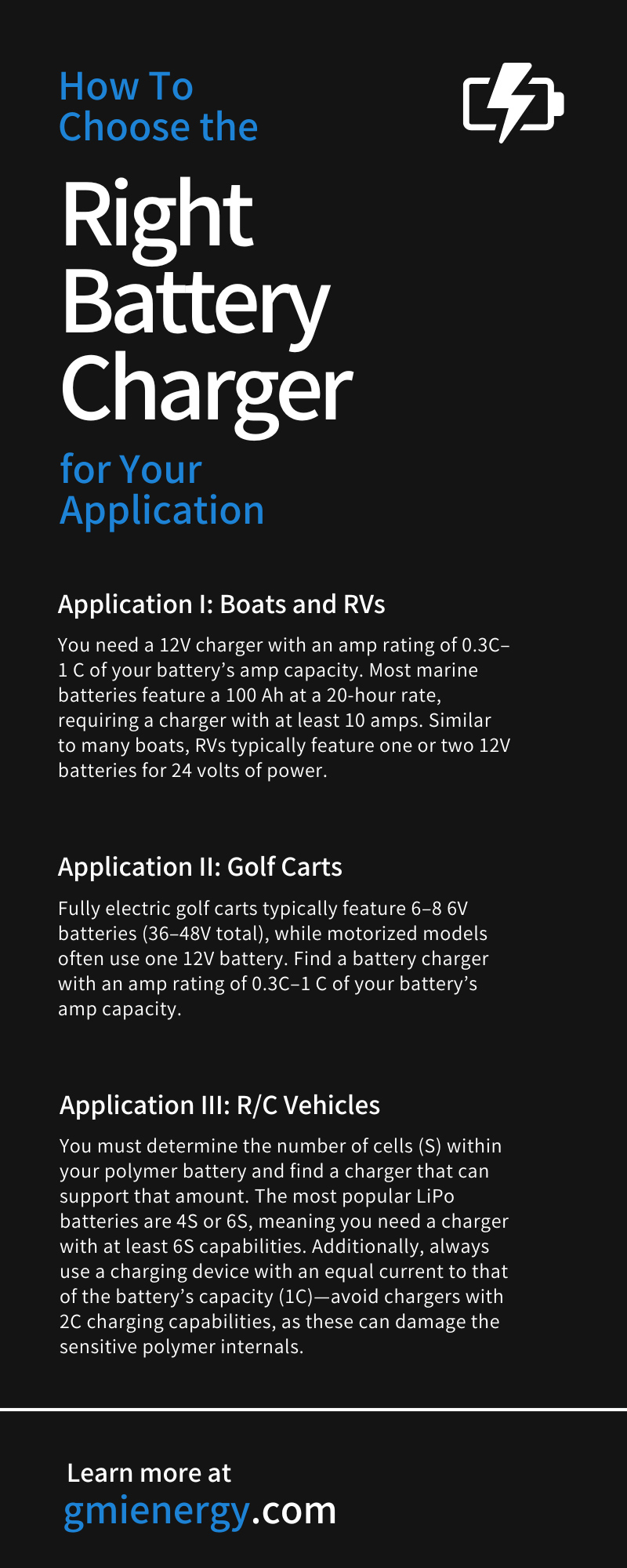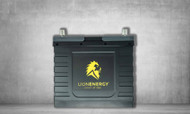How To Choose the Right Battery Charger for Your Application
Posted by GMI Energy on May 24, 2023
Do you know how to choose the right battery charger for your specific application? If not, don’t panic—most individuals aren’t even aware of battery charger requirements and specifications. However, it’s essential that you understand the proper steps to identifying a suitable charging device for your battery to ensure it has superior performance and lifespan. Read on to learn more about different charger requirements.
Battery Characteristics and Calculating Charger Amp Ratings
Before we dive into the many different battery charger applications, it’s crucial that you understand these three essential battery characteristics—type, capacity, and input voltage. Type refers to the battery style, such as lithium, lead-acid, or AGM. Capacity is the battery’s amp-hour rating (Ah), while input voltage notes the power specifications. Basically, you must find a battery charger suitable for your battery’s type, capacity, and input voltage!
To do this, you must know some easy math. Let’s start with input voltage since you need a charger with the same output voltage. For example, a 12v battery needs a 12v charger—exceeding this voltage limit can significantly damage the battery’s internals.
Next, you must calculate the amp rating of a potential charger to match the capacity of your battery. First, determine the length of your battery’s recharging processes by identifying the number of amps per bank. For instance, 5 and 6 amps per bank typically require 10–12 hours of recharging—more amps per bank lowers the recharge period requirements, allowing for more efficient battery cycles.
Once you have this information, take the amp-hour rating of your battery and multiply this number by 10 percent. The sum is the ideal charging amp rating for your specific battery! So a battery with a 100 amp-hour rating would require a 10-amp charger for the best results. We will use this math equation for the duration of this blog to help you identify the perfect charger for your application.
Application I: Boats and RVs
Boats and RVs both rely heavily on batteries to power a plethora of motor, propulsion, and emergency functions. On watercraft, specifically, marine batteries control backup power and various onboard elements, like lighting and audio. In some instances, batteries even produce hybrid marine power (HMP), a sustainable alternative to traditional fuel configurations.
On RVs, batteries are responsible for making your mobile home more hospitable and comfortable. Along with certain motor functions, separate batteries power the lighting systems, appliances, temperature controls, and plug-in electronics throughout the RV. Without enough battery power onboard, RVs would just be excessively large vehicles!
Finding the Ideal Boat and RV Battery Charger
Every boat is different, but the majority of boats under 14 feet long often require a 12V battery. Boats exceeding 15 feet long demand an additional 12 volts of power, plus an additional battery for a trolling motor, if needed. So your specific vessel probably uses one or two batteries to produce 12–24 volts of power.
You need a 12V charger with an amp rating of 0.3C–1C of your battery’s amp capacity. Most marine batteries feature a 100 Ah at a 20-hour rate, requiring a charger with at least 10 amps. Similar to many boats, RVs typically feature one or two 12V batteries for 24 volts of power. Note that most AGM batteries can only withstand a 30 percent amp-hour rating, while certain lithium batteries can receive 1C thresholds (with some reduction in battery lifespan).
Bonus Applications: Onboard Boating Equipment
Your boat may also feature various onboard equipment that requires battery power. For example, fish finders are popular fishing devices that locate dense pockets of marine life quickly and accurately. More often than not, fish finding equipment is wired directly into the boat’s battery configuration. However, non-motorized watercraft, like kayaks, don’t have an existing battery to power your sonar device—instead, you need a separate battery and charger. Since most fish finders use 12V batteries, we recommend a 12V charger with 10 to 20 amps—don’t exceed 30 amps, as this current can strain 12V batteries.
Application II: Golf Carts
Golf carts are more than convenient transportation while at the golf course—many individuals use these vehicles as daily drivers throughout their communities or as helpful tools to navigate large properties. And like all other motorized vehicles, golf carts require batteries! Golf cart batteries power all-electric motor components and dramatically impact performance capabilities. These golf cart batteries demand specific and quality charging devices to ensure proper functionality throughout the day.
Finding the Ideal Golf Cart Battery Charger
Similar to marine and RV batteries, golf cart batteries require chargers with matching voltage ratings. Fully electric golf carts typically feature 6–8 6V batteries (36–48V total), while motorized models often use one 12V battery. Find a battery charger with an amp rating of 0.3C–1C of your battery’s amp capacity. Lithium batteries and chargers with this relative amp capacity can completely refill batteries in a few hours or less! Conversely, traditional golf cart batteries often take 8–10 hours to achieve a full charge and can only withstand 0.3C (30 percent) thresholds.
Application III: R/C Vehicles
While boats, RVs, and golf carts rely on large lithium, AGM, or lead-acid batteries, R/C vehicles require a smarter power source. Traditionally, R/C operators used nickel-based NiMH or NiCD batteries to power their tiny cars, planes, and helicopters. However, NiMH and NiCD batteries are bulky and hinder the overall performance of the R/C device. Because of this, many R/C vehicles these days—especially drones and other mobile film equipment—run on Luthium-ion polymer (LiPo) batteries. Mainly, LiPos offer superior energy efficiency and high energy density, providing faster acceleration speeds and longer operating times. Plus, LiPo batteries are simple to charge for more use in the future!
Finding the Ideal LiPo Battery Charger
Determining the perfect LiPo battery charger differs greatly from finding one for AGM or lithium batteries. Primarily, you must determine the number of cells (S) within your polymer battery and find a charger that can support that amount. The most popular LiPo batteries are 4S or 6S, meaning you need a charger with at least 6S capabilities. Additionally, always use a charging device with an equal current to that of the battery’s capacity (1C)—avoid chargers with 2C charging capabilities, as these can damage the sensitive polymer internals.
Use this guide on how to choose the right battery charger for your application to ensure you get the best performance capabilities and battery lifespan! Luckily, you can purchase the ideal lithium battery charger or related product here at GMI Energy—browse our quality selection today.


